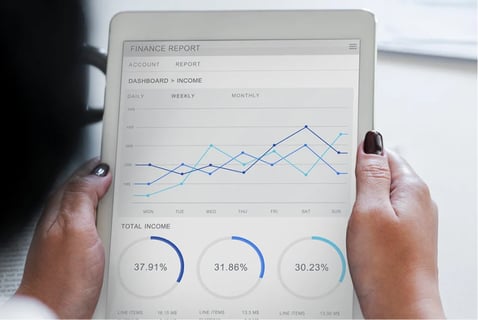Research & Insights
Uncovering Brand Truths Through Metrics, Research, and Insights
Overview:
What Are Brand Metrics?
An integral part of the brand strategy process, metrics help businesses understand how their brand is performing against customer expectations and competing brands. Strategically leveraging metrics enables your business to differentiate itself from the competition and effectively monitor brand health company-wide.
The Components of Effective Market Research & Insights
In service of our brand strategy work, FullSurge employs multiple forms of qualitative and quantitative market research. Depending on the issue set we’re addressing, we use market research to achieve different objectives. For example, our research may be exploratory in nature, such as fielding a segmentation study to better understand how customers “cluster” in terms of needs, attitudes, or behaviors. Conversely, we may use market research for validation purposes—for example, to determine which of several positioning strategies is ideal.
Regardless of the desired objective and the methodology selected, FullSurge has the ability to design, execute, analyze and interpret market research studies. Importantly, they are always in service of informing our brand strategy recommendations.
Our Process
Questions
Addressed
- How do customers segment in terms of attitudes, needs and behaviors?
- Which of several potential value propositions represents the optimal strategic direction?
- Where do customers see potential white space (unmet needs) within the marketplace?
Typical
Challenges
- The target market is highly niche, elusive and/or difficult to reach/recruit
- Multiple methodologies could potentially work, and it’s difficult to know which one is best
- Qualitative and quantitative research results lead to different (conflicting) solutions
Ensuring
Success
- It is important to understand “burden of proof” before selecting a research methodology
- Market research should always serve as an “aid to judgment”—not the final answer
- Quality and integrity in process and approach need to be maintained through entire process
Get to Know More
Improve Brand Performance Through Better Measurement and Metrics
Clear the Confusion Around Brand Measurement
Research & Insights Case Studies
Let’s get in touch!
Research & Insights FAQs
Brand metrics are quantitative measures used to assess the effectiveness and impact of a brand's strategies and campaigns. Common brand metrics include brand awareness, brand consideration, brand equity, brand loyalty, and brand sentiment. These metrics help marketers evaluate how well the brand is recognized, perceived, and favored in the market, and the extent to which it is achieving its desired brand positioning.
A Key Performance Indicator (KPI) for a brand is a specific metric selected to measure the success of brand initiatives against defined goals. Common KPIs for branding might include customer acquisition cost, customer lifetime value, social media engagement rates, and conversion rates from branding campaigns. These indicators help determine the efficiency and effectiveness of branding efforts.
Brand insights are deep, actionable understandings derived from data analysis about how consumers interact with and feel about a brand or category. These insights can reveal the target audience's preferences, behaviors, and motivations. They are crucial for shaping effective brand strategies, new product development, and marketing campaigns.
There are myriad ways market research can help inform brand strategy, including how a brand is positioned, what its architecture should be, how to craft its experience, and how it can be safely and opportunistically extended. Common questions include:
- Which customers represent the greatest opportunity for my brand, what is required to win them, and how do I find them?
- How should I position my brand to capture that opportunity in the most profitable way? What changes need to be made relative to the perception of my brand today?
- What brand architecture is likely to be optimal for customer clarity and understanding and my business objectives?
- How can I leverage my brand to be a better growth driver for my business?
- Which customer experience elements are most important to delivering on my brand’s positioning?
- Where should I focus my marketing resources to drive greater productivity?
How do I know if my marketing activities are effective?
Market research methods can be classified in at least four separate ways. Each has its benefits and drawbacks. Here is a high-level overview of each.
Primary Qualitative: Often used to understand the underlying patterns that lead people to different decisions and behaviors. Techniques include focus groups, in-depth interviews, dyads/triads, ethnography, observation, shop-along, diaries/journals, and social listening.
Primary Quantitative: Often used to produce statistically valid data to test hypotheses, validate assumptions, and support business decisions. Techniques include cluster analysis, conjoint analysis, discrete choice modeling, factor analysis, concept testing, MaxDiff scaling, perceptual maps, and structural equation modeling.
Secondary Reports: Often used to understand key factors of an industry, market share, and trends (sometimes first published as primary research, then “repackaged” and sold to others at slightly lower cost). Examples include LexisNexis, Mintel, Forrester, Gartner, and Frost & Sullivan.
Secondary Syndicated Data: Often used to provide broad insights and context prior to conducting primary (can be qualitative or quantitative). Examples include public sources such as governments (e.g., US Census Bureau), market research firms, and publishers of business and trade publications (e.g., AC Nielsen, Simmons Market Research Bureau).
Conducting brand strategy research involves several steps: defining the research objectives, choosing appropriate research methods (qualitative, quantitative, or a mix), collecting data, and analyzing this data to uncover insights that inform strategic decisions. Depending on objectives, the research might focus on understanding the brand’s current market position, identifying customer needs and gaps in the market, or testing potential brand messages and positioning strategies.















